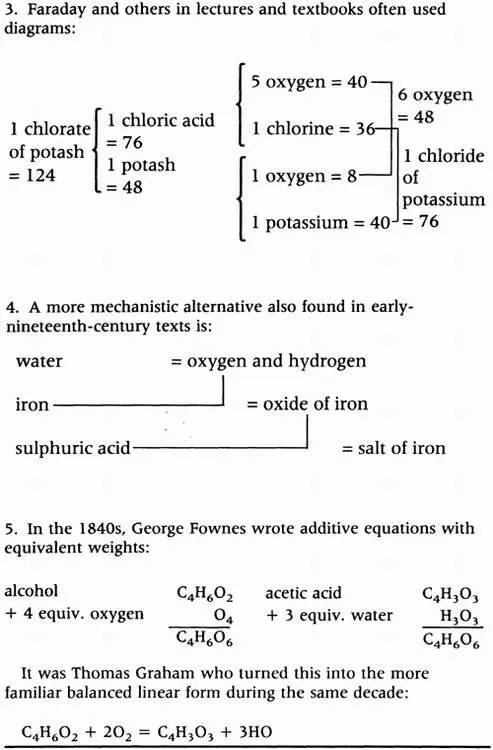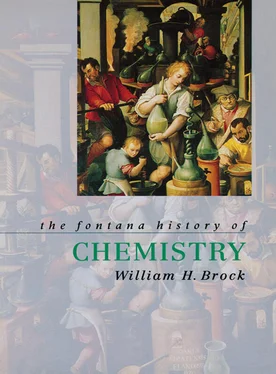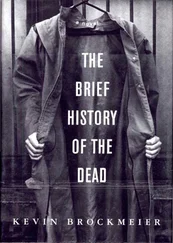the convention that Davy had already introduced, Berzelius was soon obliged to conform to the definition that electropositive substances were attracted to the negative pole. It was because of the theoretical implications of galvanic language that Faraday, in 1832, introduced the valueneutral nomenclature of electrodes, cathodes, anodes and so on. Berzelius’ electropositive and electronegative substances then became anions and cations respectively.
Oxygen, according to Berzelius, was unique in its extreme electronegativity. Other, less electronegative substances, like sulphur, could be positive towards oxygen and negative towards metals. On combination, a small residual contact charge was left, which allowed further combination to occur to form salts and complex salts. Thus, electropositive metals might form electropositive (basic) oxides (as electrolysis demonstrated), which would combine with electronegative acidic oxides to form neutral salts. The latter, however, might still have a residual charge that allowed them to hydrate and to form complex salts:
The scheme allowed the elements to be arranged in an electrochemical series from oxygen to potassium, based upon the electrolytic behaviour of elements and their oxides. Because salts were defined as combinations of oxides, Berzelius had to insist for a long time that chlorine and iodine were oxides of unknown elements, and that ammonia was similarly an oxide of ‘ammonia’. It was not until the 1820s that Berzelius finally capitulated and agreed that chlorine, iodine and bromine (which he placed in the special category of forming electronegative ‘haloid’ salts) were elements and that ammonia was a compound of nitrogen and hydrogen only.
It was this electrochemical system which was to have far-reaching analogical implications for the classification of organic substances. It also allowed Berzelius in 1813 to introduce a rational symbolism based upon the Latin names of the elements. Compounds were denoted by a plus sign between the constituents, as in copper oxide, Cu + O, the electropositive element being written first. Later, Berzelius dispensed with the plus sign and set the two elements side by side as in algebra. Different numbers of elements were then indicated by superscripts, e.g. S 2O 3,a molecule of ‘hyposulphuric acid’. These joined symbols, which were criticized initially for being potentially confusing with algebraic symbolism, only began to be used in the 1830s. It was Liebig who, in 1834, introduced the subscript convention we still use today, though French chemists went on using superscripts well into the twentieth century. Because of the importance of oxygen in Berzelius’ system, he abbreviated it to a dot over its electropositive congener, i.e. Cu = Cu + O. In 1827 he extended this to sulphur, which was indicated by a comma, i.e. copper sulphide, Cú.
In a further ‘simplification’, which in practice wrought havoc in the classification of organic compounds and in communication between chemists, Berzelius in 1827 introduced ‘barred’ or underlined symbols to indicate two atoms of an element. (Since the bar was one-third up the stem of the symbol it involved printers making a special type, thereby losing one advantage over Dalton’s symbols; hence the use of underlined symbols in some texts.) The symbols for water and potash alum thus became, respectively:
Although Berzelius introduced symbols as a memory aid to chemical proportions, they were initially adopted by few chemists. Berzelius himself virtually ignored his own suggestions until 1827, when he published the organic chemistry section of his textbook, which appeared in German and French translations soon afterwards. Indeed, the development of organic chemistry was undoubtedly the key factor into pushing chemists into symbolic representations. Following the determination of a group of younger British chemists to introduce Continental organic research into Britain, Edward Turner employed Berzelius’ symbols in the fourth edition of his Elements of Chemistry in 1834. From then on, together with chemical equations, whose use in Britain was pioneered by Thomas Graham, symbols became an indispensable part of chemical communication.
TABLE 4.2 The development of the chemical equation.


As we have seen, Dalton angrily rejected Berzelius’ symbols mainly on the grounds that they did not indicate structure but were merely synoptic. Nor was he at all pleased with the way Berzelius had taken over his creation and transformed it electrochemically. On his part, Berzelius, after struggling for years to obtain a copy of Dalton’s New System , expressed deep disappointment with the book when he eventually read it in 1812 7 :
I have been able to skim through the book in haste, but I will not conceal that I was surprised to see how the author has disappointed my hopes. Incorrect even in the mathematical part (e.g. in determining the maximum density of water), in the chemical part he allows himself lapses from the truth at which we have the right to be astonished.
Berzelius’ extensive account of his interpretation of Dalton’s theory was published in English in Thomas Thomson’s monthly Annals of Philosophy in 1813. These articles were criticized by Dalton on at least five grounds. Whereas Dalton could see no good reason geometrically why atoms had to be spherical or all the same size, these were cardinal assumptions of Berzelius, who put them to good use in 1819 when he explained the isomorphism of crystals that Mitscherlich had discovered when studying with him in Stockholm. (Isomorphism refers to the fact that a family of salts containing different metals tend to have similar or identical crystal shapes.) Again, unlike Dalton, Berzelius refused to allow combinations of the type 2A + 2B or 2A + 3B on the grounds that, logically, nothing would prevent such ‘atoms’ from being divided. Dalton disagreed, since self-repulsions could be appealed to. Only after a lifetime’s analysis, in 1831, did Berzelius accept that occasionally two atoms of an element could combine with two or more other atoms. Before then this had led Berzelius to assume that all metallic oxides had the form MO. In the cases of the alkali metals and of silver, which are actually M 2
Конец ознакомительного фрагмента.
Текст предоставлен ООО «ЛитРес».
Прочитайте эту книгу целиком, купив полную легальную версию на ЛитРес.
Безопасно оплатить книгу можно банковской картой Visa, MasterCard, Maestro, со счета мобильного телефона, с платежного терминала, в салоне МТС или Связной, через PayPal, WebMoney, Яндекс.Деньги, QIWI Кошелек, бонусными картами или другим удобным Вам способом.














